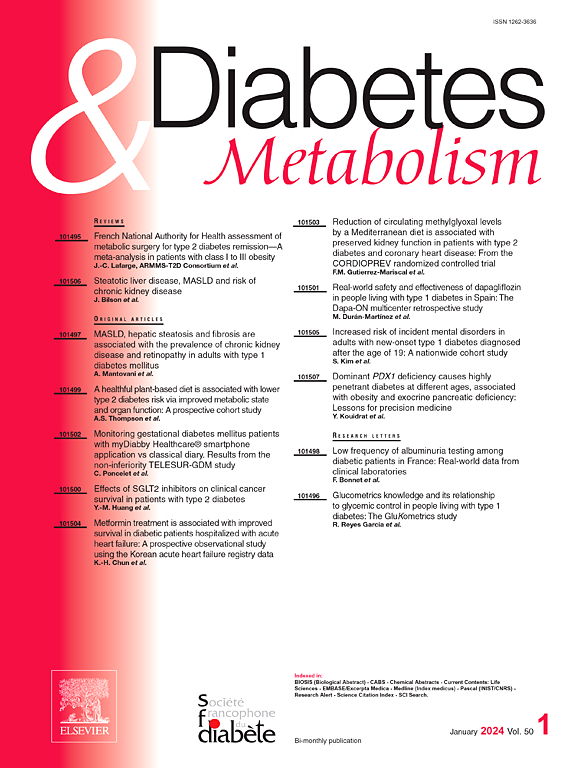Musculoskeletal disorders in type 1 diabetes: Clinical phenotyping and associations with quality of life and glucose control - The French SFDT1 cohort study
IF 4.7
2区 医学
Q1 ENDOCRINOLOGY & METABOLISM
引用次数: 0
Abstract
Background
Musculoskeletal disorders (MSDs) are common, but overlooked, complications of type 1 diabetes mellitus (T1DM). This study aims to describe MSD phenotypes (clinical, lifestyle, socio-economic) in adults with T1DM.
Methods
We analyzed adult participants in the SFDT1 cohort study. We assessed the following MSDs: stress fractures, non-traumatic upper-limb disorders, and entrapment syndromes. We performed a cross-sectional analysis of the association between MSDs and various factors. After applying multiple imputations for missing data, we computed logistic regression models with progressive adjustments on confounding factors.
Results
Of 1832 participants (53 % men, median age 38 (IQR 22) years), 34 % reported at least one personal history of MSD: 8 % for stress fractures, 24 % for upper-limb disorders and 15 % for entrapment syndromes. A higher prevalence of MSDs was found in women, with aging and with diabetes duration. In a fully adjusted model, we observed a positive association between current smoking (OR [95 %CI] = 1.50 [1.14;1.97]), non-excessive alcohol consumption (1.45 [1.14;1.85]), neuropathy (1.70 [1.35;2.15]), retinopathy (1.30 [1.02;1.65]), use of automated insulin delivery systems (1.53 [1.06;2.21]) and MSDs. MSDs were associated with reduced global quality of life (0.97 [0.95;0.98]). MSDs were not associated with HbA1c, social vulnerability or physical activity.
Conclusion
We have shown that MSDs are found in 1 in 3 people with T1DM. They are associated with several lifestyle factors, diabetes complications and the use of automated insulin delivery systems. MSDs should be considered in the T1DM assessment to optimize quality of life.
1型糖尿病的肌肉骨骼疾病:临床表型及其与生活质量和血糖控制的关系——法国SFDT1队列研究
背景:肌肉骨骼疾病(MSDs)是1型糖尿病(T1DM)常见但被忽视的并发症。本研究旨在描述成年T1DM患者的MSD表型(临床、生活方式、社会经济)。方法我们分析SFDT1队列研究中的成年参与者。我们评估了以下msd:应力性骨折、非创伤性上肢障碍和夹带综合征。我们对MSDs与各种因素之间的关系进行了横断面分析。在对缺失数据进行了多重输入后,我们计算了对混杂因素进行渐进调整的逻辑回归模型。结果在1832名参与者中(53%为男性,中位年龄38岁(IQR 22)), 34%报告至少有一次个人MSD病史:8%为应力性骨折,24%为上肢疾病,15%为夹带综合征。随着年龄的增长和糖尿病病程的延长,女性中MSDs的患病率更高。在一个完全调整的模型中,我们观察到当前吸烟(OR [95% CI] = 1.50[1.14;1.97])、非过量饮酒(1.45[1.14;1.85])、神经病变(1.70[1.35;2.15])、视网膜病变(1.30[1.02;1.65])、使用自动胰岛素输送系统(1.53[1.06;2.21])和msd之间的正相关。MSDs与总体生活质量降低相关(0.97[0.95;0.98])。MSDs与HbA1c、社会脆弱性或身体活动无关。结论:1 / 3的T1DM患者存在msd。它们与几种生活方式因素、糖尿病并发症和使用自动胰岛素输送系统有关。在T1DM评估中应考虑MSDs,以优化生活质量。
本文章由计算机程序翻译,如有差异,请以英文原文为准。
求助全文
约1分钟内获得全文
求助全文
来源期刊

Diabetes & metabolism
医学-内分泌学与代谢
CiteScore
12.00
自引率
4.20%
发文量
86
审稿时长
13 days
期刊介绍:
A high quality scientific journal with an international readership
Official publication of the SFD, Diabetes & Metabolism, publishes high-quality papers by leading teams, forming a close link between hospital and research units. Diabetes & Metabolism is published in English language and is indexed in all major databases with its impact factor constantly progressing.
Diabetes & Metabolism contains original articles, short reports and comprehensive reviews.
 求助内容:
求助内容: 应助结果提醒方式:
应助结果提醒方式:


